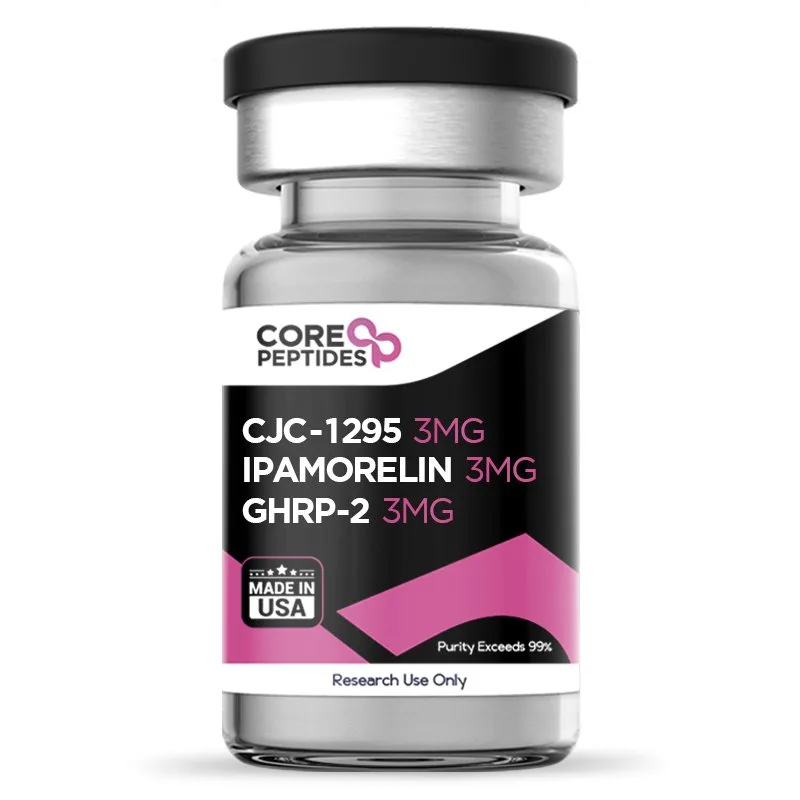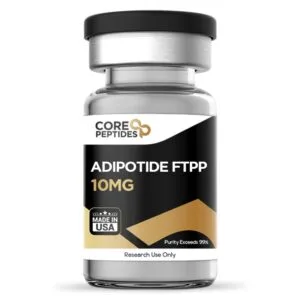CJC-1295 (Mod GRF 1-29) & Ipamorelin & GHRP-2 Blend (9mg)
$81.00
Size: 9mg
Contents: CJC-1295 NO DAC (Mod GRF 1-29) (3mg), Ipamorelin (3mg), GHRP-2 (3mg)
Form: Lyophilized powder
Purity: >99%
SKU: P-CJCIPAMGHR2-9
FREE Shipping on $200+ orders
Discount per Quantity
| Quantity | Discount | Price |
|---|---|---|
| 5 - 8 | 5% | $76.95 |
| 9 + | 10% | $72.90 |
CJC-1295 (Mod GRF 1-29) & Ipamorelin & GHRP-2 Peptide Blend
CJC-1295 (Mod GRF 1-29), Ipamorelin, and GHRP-2 are all synthetic peptides that are suggested by research teams to potentially stimulate the release of growth hormone. Anecdotal reports suggest that all three peptides appear synergistic when combined as a blend, potentially providing unique peptide action.
CJC-1295 (Mod GRF 1-29) is considered to be an agonist to the receptors for the native Growth Hormone-Releasing Hormone (GHRH). It is an analog of its truncated version called GHRH (1-29) which appears to potentially have the same affinity to the receptors. GHRH 1-29 is potentially the shortest functional sequence of GHRH made up of its initial 29 amino acids. CJC-1295 (Mod GRF 1-29) is a variation that has undergone tetrasubstitution and has been further modified with the addition of a drug affinity complex (DAC) element named N-epsilon-3-maleimidopropionamide. This component may, perhaps, bind to plasma proteins, possibly enhancing the pharmacokinetics of CJC-1295 (Mod GRF 1-29).
Ipamorelin is a pentapeptide that apparently mirrors the effects of the natural hunger hormone, ghrelin. This hormone may activate the ghrelin receptors in the pituitary gland, also known as the Growth Hormone Secretagogue receptors (GHS-R1a) which may trigger the release of growth hormone.
GHRP-2, also known as Growth Hormone Releasing Peptide 2, is a hexapeptide crafted from six distinct amino acids. It is a synthetic peptide analogous to the receptors of the naturally occurring peptide called ghrelin (aka the GHS-R1a receptors). Thus, GHRP-2 and Ipamorelin peptides appear to trigger GHS-R1a and potentially stimulate the release of growth hormone. However, they may also possibly increase food intake due to their reported effect on ghrelin receptors. This is why they are classified by researchers as Growth Hormone Secretagogues (GHSs).
Chemical Makeup (3)(4)(5)
Molecular formula:
- CJC-1295 (Mod GRF 1-29): C152H252N44O42
- Ipamorelin: C38H49N9O5
- GHRP-2: C45H55N9O6
Molecular weight:
- CJC-1295 (Mod GRF 1-29): 3367.9 g/mol
- Ipamorelin: 711.9 g/mol
- GHRP-2: 817.9 g/mol
Other known titles:
- Ipamorelin Ipamorelin Acetate, IPA
- GHRP-2 Pralmorelin, Growth hormone-releasing peptide-2
Research and Clinical Studies
CJC-1295 (Mod GRF 1-29), Ipamorelin, GHRP-2 Blend and Growth Hormone Deficiencies
Numerous clinical studies have been conducted on test subjects exhibiting growth hormone deficiency. These studies are recorded here for educational and research purposes; studies like these are ongoing and do not offer conclusive evidence of the peptide’s potential mechanism of action. In these clinical trials, peptides stimulating growth hormone release appeared to deliver some action in two ways – possibly either via stimulating the pituitary gland to release growth hormones, or possibly acting on the arcuate nucleus of the hypothalamus. While these peptides (including GHRP-2, Ipamorelin, and CJC-1295 (Mod GRF 1-29)) appeared to exhibit high releases of growth hormones, it remains unclear which of the two mechanisms worked. In addition, these studies suggested that these peptides may modulate food intake, cardiac tone, and sleep through apparently specific receptor agonistic action.(4)
In another study,(5) six growth hormone-deficient test subjects facing growth failure were presented with growth hormone-stimulating peptides. All subjects were monitored for episodic growth hormone secretion and toxicity levels during this period. For the duration of the study and short while afterwards, It was observed that there appeared to be a gradual rise in the concentration of growth hormones in all subjects. As per V Mericq et al., the studies suggested that the peptides were “well tolerated and […] stimulate GH secretion.” Studies such as this one are still underway, and these peptides require further research.
CJC-1295 (Mod GRF 1-29) (Mod GRF 1-29), Ipamorelin, GHRP-2 Blend, and Food Intake
In this clinical study,(6) test subjects were presented with GHRP-2 and then presented with unlimited food supply to measure food intake. It was reported that the subjects with peptide presence ate approximately 36% more than the control subjects did. In addition, the growth hormone levels were reportedly increased in these subjects, suggesting the action the peptides had on both food intake and growth hormone levels. As per this study, the growth hormone release-stimulating peptides appeared to be a “valuable tool for investigating the effects on eating behavior.” Research studies are still ongoing to fully explore the potential of peptide blends.
Given its potential influence on the ghrelin receptors, Ipamoreline might also potentially enhance appetite and, perhaps, lead to weight gain. One study suggests that Ipamorelin may have possibly contributed to a roughly 15% rise in the body weight of the experimental subjects.(7) Researchers have posited the theory that Ipamorelin might have, to some extent, augmented the fat pad weights in proportion to overall body weight. This may have resulted in a relative increase in body fat as measured by dual energy X-ray absorptiometry (DEXA). Moreover, there is an indication that Ipamorelin might have elevated serum leptin levels, a hormone that is thought to play a role in energy and appetite regulation. Consequently, scientists speculated that the Ipamorelin groups might have experienced an uptick in food consumption leading to an apparent weight gain.
Thus, Ipamorelin and GHRP-2 appear may potentially have synergistic effects on increasing hunger levels. On the other hand, CJC-1295 (Mod GRF 1-29) (Mod GRF 1-29) has not been suggested to affect appetite.
CJC-1295 (Mod GRF 1-29) (Mod GRF 1-29), Ipamorelin, GHRP-2 Blend, and Bone Mass
By apparently increasing growth hormone synthesis, all three peptides may potentially upregulate bone mineral density. Yet, Ipamorelin appears to be the most researched of these three peptides for this focus.
In a particular study, murine subjects were either exposed to Ipamorelin or a control agent.(8) The potential effects of Ipamorelin on bone mineral density were monitored in real-time using dual X-ray absorptiometry (DXA) at specific locations, including the femur and L6 vertebrae. After the research duration, the murine subjects' femurs underwent analysis with mid-diaphyseal peripheral quantitative computed tomography (pQCT) scans. The findings tentatively indicate that the peptide might have contributed to a potential weight gain and a potential uptick in the overall tibial and vertebral BMC (bone mineral content) as observed via DXA, in contrast to the control set. Yet, when accounting for the weight gain in the total BMC, there seemed to be no notable difference as per the researchers. There might have been a slight increase in the bone mineral density (BMD) of the tibial region, but the overall and vertebral BMDs appeared to stay stable. The pQCT data perhaps suggests that the rise in cortical BMC may be attributed to a growth in the cross-sectional bone area, even though the cortical volumetric BMD seemingly stayed the same. Both the femur and L6 vertebrae volumes might have experienced a growth, but the volumetric BMDs did not appear to shift.
These observations hint at the theory that the increase in both cortical and total BMC may potentially stem from improved bone growth leading to expanded bone dimensions, with the volumetric BMD staying consistent. The researchers further suggest that GHRPs may also increase BMC/BMD.
CJC-1295 (Mod GRF 1-29) (Mod GRF 1-29), Ipamorelin, GHRP-2 Blend, and Muscle Mass
The main focus on CJC-1295 (Mod GRF 1-29) (Mod GRF 1-29) & Ipamorelin & GHRP-2 research has been on the peptides’ potential synergy in regards to increasing muscle mass. Studies on murine models with a GHRH gene deletion (referred to as GHRHKO), hinted that CJC-1295 (Mod GRF 1-29) (Mod GRF 1-29) may potentially have favorable action on lean mass.(9)
When influenced by CJC-1295 (Mod GRF 1-29) (Mod GRF 1-29), GHRHKO models appeared to retain typical lean weight and length, unlike the control groups which reportedly struggled to reach standard weight and dimensions. Furthermore, both the comparative lean mass and the underlying fat mass in all groups linked with the peptide seemed to stay consistent with control measurements in normal murine models. This suggests that CJC-1295 (Mod GRF 1-29) (Mod GRF 1-29) might favorably impact muscle and bone structures without necessarily promoting heightened fat accumulation. The researchers also observed a potential uptick in overall pituitary RNA and GH mRNA due to CJC-1295 (Mod GRF 1-29) (Mod GRF 1-29), implying a potential surge in somatotroph cells - the cells in the pituitary gland thought to generate growth hormone. This speculated cell growth was additionally supported by visual evidence from immunohistochemistry.
Ipamorelin has also been proposed to increase lean mass, as suggested by the positive nitrogen balance reported in some preliminary studies. In a particular study, researchers sought to explore the potential metabolic effects of Ipamorelin on certain liver markers related to alpha-amino-nitrogen transformation during what might be steroid-induced catabolism. The team attempted to gauge the liver's ability to produce urea-N (CUNS), which could be an indicative measure of nitrogen processing in the liver. They observed potential variations in messenger RNA (mRNA) levels linked with liver urea cycle enzymes, assessed the general nitrogen equilibrium, and speculated on the nitrogen composition of different organs. Researchers suggested that Ipamorelin might have led to an approximate 20% decrease in CUNS in contrast to the catabolic condition potentially brought about by steroids. Moreover, it could have perhaps diminished the activity of urea cycle enzymes, reestablished nitrogen equilibrium, and maybe adjusted or enhanced the nitrogen levels in organs.
CJC-1295 (Mod GRF 1-29) (Mod GRF 1-29) & Ipamorelin & GHRP-2 Peptide Blend is available for research and laboratory purposes only. Please review and adhere to our Terms and Conditions before ordering.
References:
- National Center for Biotechnology Information (2023). PubChem Compound Summary for CID 91976842, CJC1295 Without DAC. https://pubchem.ncbi.nlm.nih.gov/compound/CJC1295-Without-DAC.
- National Center for Biotechnology Information (2023). PubChem Compound Summary for CID 9831659, Ipamorelin. https://pubchem.ncbi.nlm.nih.gov/compound/Ipamorelin.
- National Center for Biotechnology Information (2023). PubChem Compound Summary for CID 6918245, Pralmorelin. https://pubchem.ncbi.nlm.nih.gov/compound/Pralmorelin.
- Rogério G. Gondo et al, Growth Hormone-Releasing Peptide-2 Stimulates GH Secretion in GH-Deficient Patients with Mutated GH-Releasing Hormone Receptor, The Journal of Clinical Endocrinology & Metabolism, Volume 86, Issue 7, 1 July 2001, Pages 3279–3283, https://doi.org/10.1210/jcem.86.7.7694.
- Mericq V, Cassorla F, Salazar T, Avila A, Iñiguez G, Bowers CY, Merriam GR. Effects of eight months treatment with graded doses of a growth hormone (GH)-releasing peptide in GH-deficient children. J Clin Endocrinol Metab. 1998 Jul;83(7):2355-60. https://pubmed.ncbi.nlm.nih.gov/9661608/
- Laferrère, Blandine et al. “Growth hormone releasing peptide-2 (GHRP-2), like ghrelin, increases food intake in healthy men.” The Journal of clinical endocrinology and metabolism vol. 90,2 (2005): 611-4. https://www.ncbi.nlm.nih.gov/pmc/articles/PMC2824650/
- Lall, S., Tung, L. Y., Ohlsson, C., Jansson, J. O., & Dickson, S. L. (2001). Growth hormone (GH)-independent stimulation of adiposity by GH secretagogues. Biochemical and biophysical research communications, 280(1), 132–138. https://doi.org/10.1006/bbrc.2000.4065
- Svensson, J., Lall, S., Dickson, S. L., Bengtsson, B. A., Rømer, J., Ahnfelt-Rønne, I., Ohlsson, C., & Jansson, J. O. (2000). The GH secretagogues ipamorelin and GH-releasing peptide-6 increase bone mineral content in adult female rats. The Journal of endocrinology, 165(3), 569–577. https://doi.org/10.1677/joe.0.1650569
- Alba M, Fintini D, Sagazio A, Lawrence B, Castaigne JP, Frohman LA, Salvatori R. Once-daily administration of CJC-1295, a long-acting growth hormone-releasing hormone (GHRH) analog, normalizes growth in the GHRH knockout mouse. Am J Physiol Endocrinol Metab. 2006 Dec;291(6):E1290-4. doi: 10.1152/ajpendo.00201.2006. Epub 2006 Jul 5. PMID: 16822960.
- Aagaard, N. K., Grøfte, T., Greisen, J., Malmlöf, K., Johansen, P. B., Grønbaek, H., Ørskov, H., Tygstrup, N., & Vilstrup, H. (2009). Growth hormone and growth hormone secretagogue effects on nitrogen balance and urea synthesis in steroid treated rats. Growth hormone & IGF research : official journal of the Growth Hormone Research Society and the International IGF Research Society, 19(5), 426–431. https://doi.org/10.1016/j.ghir.2009.01.001






